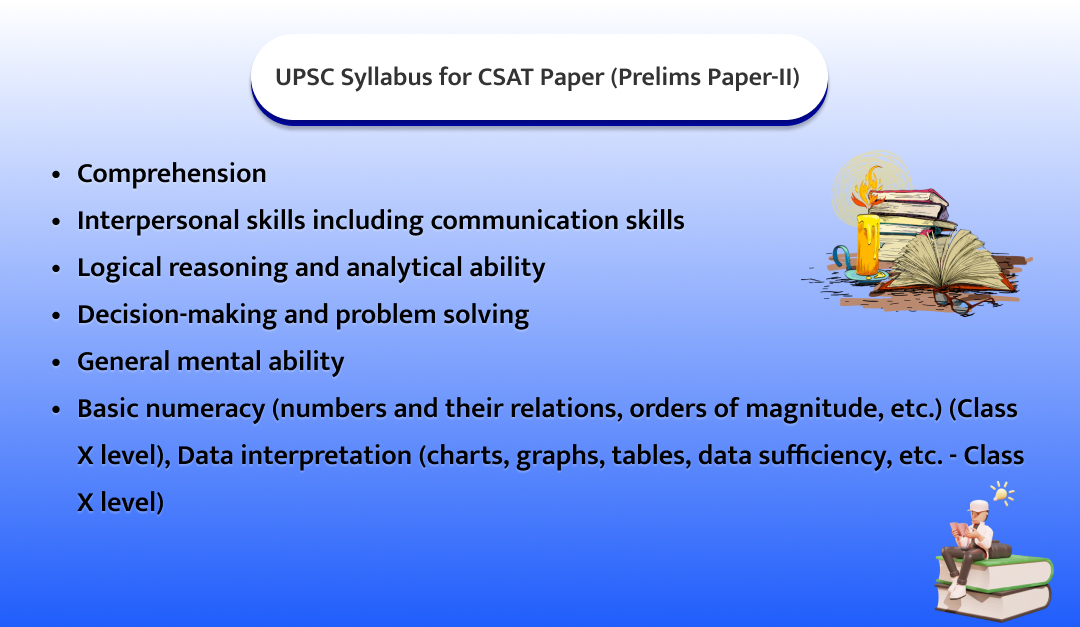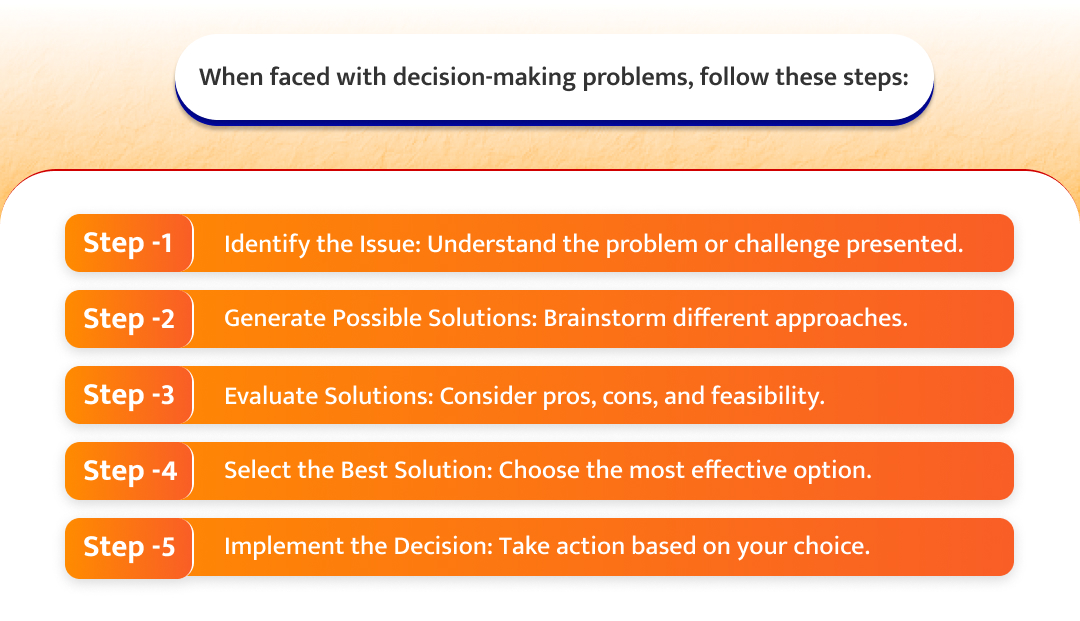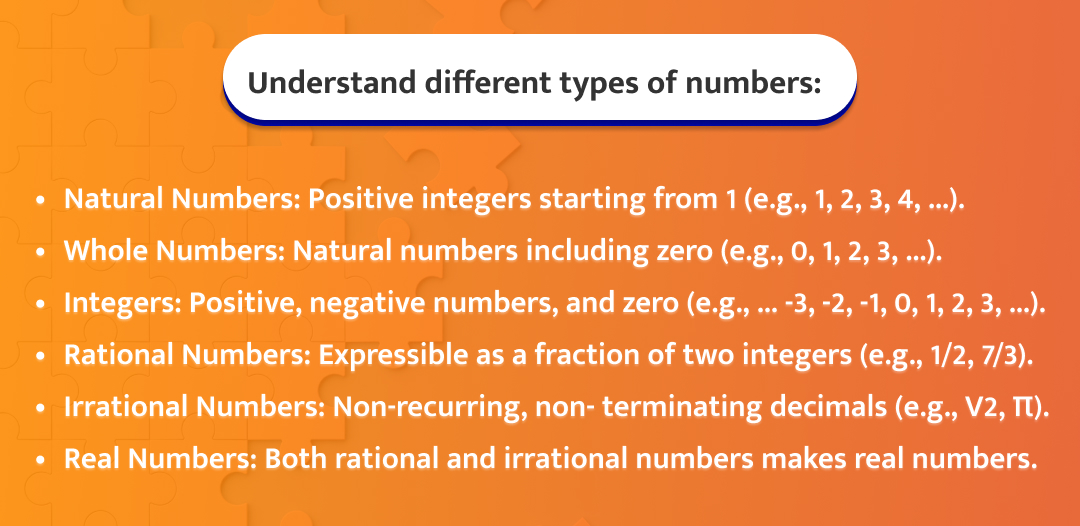
The UPSC CSAT (Civil Services Aptitude Test) holds immense significance in the journey of aspiring civil servants. As the qualifying paper for the UPSC Preliminary Exam, it serves as a
gateway to the Mains stage. The CSAT evaluates candidates’ comprehension, logical reasoning, and decision-making and basic numeracy skills.
It ensures that aspirants possess the essential aptitude required for administrative roles. Understanding the CSAT syllabus thoroughly allows
candidates to strategically focus on crucial topics and confidently tackle the exam. The CSAT is not only a stepping stone but also a litmus test of suitability for civil services.
Therefor it is important to understand the UPSC CSAT Syllabus.
Significance of UPSC CSAT (Civil Services Aptitude Test) Syllabus 2025
Understanding the UPSC CSAT (Civil Services Aptitude Test) syllabus is crucial for effective preparation. Let me break down its significance:
- Qualification for Mains: The CSAT, also known as GS Paper-2, is a mandatory part of the UPSC Preliminary Exam. Clearing this paper is essential to qualify for the Mains stage.
- Assessment of Skills: The CSAT evaluates candidates’ abilities in:
- Comprehension: Understanding passages and answering questions.
- Logical Reasoning: Analysing patterns, making deductions, and solving problems.
- Decision-Making: Evaluating options.
- General Mental Ability: Assessing cognitive skills.
- Basic Numeracy: Testing fundamental math skills.
- Suitability for Civil Services: The CSAT plays a crucial role in determining a candidate’s suitability for civil services. It assesses skills necessary for administrative roles.
- Effective Preparation: By understanding the syllabus, staying updated with changes, and focusing on essential topics, you can confidently tackle the CSAT paper.
Remember, the CSAT is qualifying in nature, so focus on important sections to qualify for the exam. Stay informed about the syllabus of UPSC CSE and prepare strategically!

Detailed UPSC CSAT Syllabus Topic Wise
CSAT is the qualifying paper for the UPSC prelims exam. The UPSC CSAT syllabus 2025 focuses on testing general aptitude. It includes comprehension, interpersonal skills, logical reasoning, decision-making, mental ability, basic numeracy, and data interpretation, all at a Scoring pattern:Class X level. It evaluates a candidate's ability to understand and interpret information, solve problems, and make sound judgments. Understanding the detailed UPSC CSAT Syllabus is crucial for effective preparation. Let's break down the UPSC CSE CSAT syllabus topic-wise and CSAT Pattern-
Understanding the UPSC CSAT (Civil Services Aptitude Test) syllabus is essential for effective preparation. Let’s break it down:
A. Comprehension:
This section of UPSC CSAT Syllabus assesses your ability to understand passages and answer questions based on them.
Mastering comprehension skills is crucial for success in the UPSC CSAT (Civil Services Aptitude Test) below is strategy to tackle comprehension passages:
Develop Speed and Accuracy:
- CSAT is a time-bound exam, so work on increasing your reading speed while maintaining accuracy.
- Avoid re-reading sentences unless necessary. Focus on understanding the core ideas.
Active Reading:
- Read passages actively, paying attention to details.
- Highlight or underline key points, unfamiliar words, and important phrases.
Vocabulary Enhancement:
- A decent vocabulary is needed. Strengthen it by:
- Learning new words from context.
- Regularly reading newspapers, especially editorials.
- Watching discussions on news channels to improve language skills.
Practice Regularly:
- Comprehension improves with consistent practice.
- Solve previous years’ CSAT comprehension papers to understand the pattern.
Understand Passage Structure:
- Identify the main idea, supporting details, and transitions within the passage.
- Recognize the author’s tone and purpose.
Evaluate Options Carefully:
- Eliminate wrong options according to your understanding of the passage.
- Avoid generalizations and extreme interpretations.
B. Interpersonal Skills:
this section of UPSC CSAT Syllabus includes communication skills and understanding human interactions. Interpersonal skills play a pivotal role in the UPSC CSAT (Civil Services Aptitude Test) and are essential for a successful career as a civil servant. Here are practical steps to enhance your interpersonal abilities:
Empathy and Active Listening:
- Try to Empathize with people by understanding them and their emotions.
- Listen actively: Pay attention, ask questions, and show genuine interest in what others say.
Effective Communication:
- Verbal Communication: Practice expressing your thoughts coherently and concisely.
- Non-Verbal Communication: Be aware of body language, eye contact, and gestures.
Conflict Resolution:
- Learn techniques to resolve conflicts peacefully.
- Understand different viewpoints and find common ground.
Ethical Decision-Making:
- Uphold integrity and ethical standards.
- Consider the impact of your decisions on others.
Teamwork and Collaboration:
- Work effectively in teams.
- Value diverse opinions and contribute positively.
C. Logical Reasoning and Analytical Ability:
You’ll encounter questions related to patterns, deductions, and problem-solving in this section of UPSC CSAT Syllabus. Mastering logical reasoning and
analytical ability is crucial for success in the UPSC CSAT (Civil Services Aptitude Test). Let’s dive into effective strategies:
Logical Reasoning:
- Think Critically: Develop the ability to identify patterns, draw conclusions, and make deductions based on information provided.
- Syllogisms: Practice solving syllogism-based questions. For example:
Question 1: All men are mortal. Kunj is a man. Therefore:
- Kunj is mortal.
- Kunj is not mortal.
- Cannot be determined.
- None of the above.
Correct Answer: A) Kunj is mortal.
Question 2: If every student who scored above 90% in the math test got a certificate, and Mehak received a certificate, what can we conclude?
- Mehak scored above 90% in the math test.
- Mehak did not score above 90% in the math test.
- All students received certificates.
- Mehak is a teacher.
Correct Answer: A) Mehak scored above 90% in the math test.
Analytical Ability:
- Break down Complex Problems:
- Analytical ability involves breaking down intricate problems into smaller components.
- Examine each component individually and synthesize information to arrive at a comprehensive understanding or solution.
- Practice Regularly:
- Solve puzzles, analytical reasoning questions, and mathematical problems.
- Enhance your ability to think critically and make informed decisions.
Diversify Your Practice:
- Engage in various question patterns to handle different CSAT scenarios effectively.
- Leverage online platforms, coaching materials, and mock tests to enhance your logical reasoning capabilities.
D. Decision-Making and Problem-Solving:
Evaluate options and make informed choices is in this section of UPSC CSAT Syllabus. Decision Making and Problem Solving is a crucial section in the UPSC CSAT (Civil Services Aptitude Test). Let’s explore effective strategies to excel in this area:
Understand the Context:
- Decision-making questions often place you in the shoes of an IAS officer or a civil servant.
- Think and take decisions as if you were in their position.
Situation Analysis:
- The most common type of question involves analysing a situation.
- Understand the context, constraints, and implications of different choices.
Five-Step Approach:

Practice Scenarios:
- Solve decision-making questions from previous years’ CSAT papers.
- Analyse case studies and practice making informed choices.
Problem-Solving Skills:
- Enhance your critical thinking abilities.
- Practice analytical reasoning exercises.
- Work on logical reasoning and pattern recognition.
E. General Mental Ability:
This section UPSC CSAT Syllabus tests your cognitive skills. General Mental Ability (GMA) is a critical component of the UPSC CSAT (Civil Services Aptitude Test). Let’s explore effective strategies to enhance your cognitive capabilities:
Understand General Mental Ability (GMA):
- GMA encompasses logical reasoning, problem-solving, numerical ability, and analytical thinking.
- It assesses your ability to interpret information, deduce conclusions, and make decisions based on given data or scenarios.
Practice Regularly: Solve pattern-based questions and puzzles.
Foundational Concepts: Brush up on basic numeracy and data interpretation.
Mock Tests: Improve speed and accuracy by solving mock test papers.
F. Basic Numeracy:
This section of UPSC CSAT Syllabus contains Fundamental math skills are essential. Basic Numeracy is a fundamental component of the UPSC CSAT (Civil Services Aptitude Test). Let’s explore effective strategies to improve your basic numeracy skills:
Understand the Basics:
- Revise Class X-Level Mathematics: Ensure a solid foundation by revisiting topics from your school days.
- Focus on concepts such as percentages, ratios, averages, and simplification.
Practice Regularly:
- Numerical Problems: Solve numerical problems regularly to build confidence in handling quantitative data.
- Work on both speed and accuracy.
-
- Relations between Numbers:
- Understand concepts like:
- Equality: Two numbers are equal if they represent the same value (e.g., 2 + 3 = 5).
- Inequality: Numbers can be greater than, less than, or equal to other numbers (e.g., 5 > 3, 2 ≤ 4).
Model Questions:
- Practice solving model questions related to basic numeracy.
- Understand the reasoning behind each step.
Types of Numbers: Understand different types of numbers.

Mock Tests and Previous Years’ Papers:
- Attempt mock tests and solve previous years’ CSAT papers.
- Analyse your performance and identify strengths and weaknesses.
G. Data Interpretation:
Analyse data and draw conclusions. In this section of UPSC CSAT Syllabus Data Interpretation is a crucial skill for the UPSC CSAT (Civil Services Aptitude Test). Let’s explore effective strategies to enhance your data interpretation abilities:
Understand the Basics:
- Read the Title: Before diving into the data, understand what the graph, table, or chart represents.
- Identify the Context: Know the subject matter (e.g., economic data, population trends, etc.).
Types of Data Representations:
- Tables: Understand rows, columns, and headers. Extract relevant information.
- Bar Graphs: Analyze bars’ heights and compare values.
- Line Graphs: Observe trends over time.
- Pie Charts: Identify proportions and percentages.
- Scatter Plots: Look for patterns and correlations.
Look for Trends and Patterns:
- Instead of getting lost in numbers, focus on patterns or trends.
- Identify outliers or significant changes.
Practice Regularly:
- Solve data interpretation questions from previous years’ CSAT papers.
- Work on both speed and accuracy.
- Use Elimination:
- Sometimes, it’s easier to eliminate incorrect answer choices than to find the right one.
- Cross out options that don’t match the data.
Understand Data Sufficiency:
- In some questions, you’ll need to determine if the given data is sufficient to answer.
- Practice solving data sufficiency problems.
Remember, the CSAT is qualifying in nature, so focus on important sections to qualify for the Mains. Consistent practice and understanding the syllabus for CSAT thoroughly will help you excel in the Civil Services Aptitude Test
CSAT Exam Pattern & Marking Scheme
The UPSC Civil Services Aptitude Test or CSAT is distinct in its pattern and marking scheme from the GS Paper I. Resultantly, it becomes essential for candidates to understand the CSAT exam pattern and marking scheme to clear the UPSC Prelims. Below is the details about the exam pattern and marking scheme:
UPSC CSAT Exam Pattern: The CSAT paper consists of 80 questions in total, which need to be completed within 2 hours. The questions test the candidates' comprehension, logical reasoning, general mental ability, and basic numeracy skills. This structure and pattern of the paper require the aspirants to manage time effectively.
In the CSAT exam pattern, each question is allotted 2.5 marks, marking a total of 200 marks. This uniform marking scheme requires focus and accuracy to maximise scores. Furthermore, a negative marking of 1/3 of the allotted mark is deducted for one wrong answer.
CSAT Exam Qualifying criteria: It is important to note that the CSAT Paper is qualifying in nature, requiring a minimum of 33% marks, i.e., 66.67 out of 200 to pass the paper.
CSAT Exam Pattern with Essential Details
| Marks allotted |
200 |
| Mode |
Offline |
| Duration |
2 hours |
| No. of Questions |
80 |
| Qualifying marks |
66.67 marks |